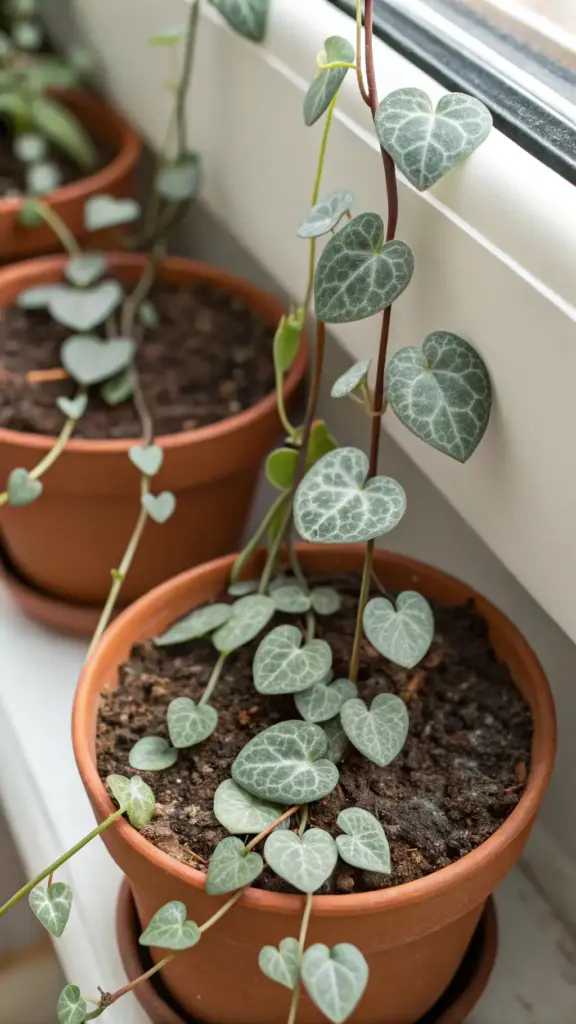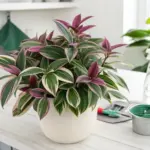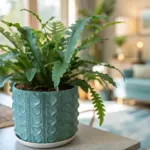5. Division Method for Mature Plants

I’ll be honest – the first time I attempted plant division on my String of Hearts, I was absolutely terrified. This gorgeous, full plant had taken me two years to grow, and I was about to chop it up like a salad!
But when I saw how garden centers could turn one massive plant into a dozen smaller ones in minutes? I knew I had to master this technique.
Recognizing a Division-Ready Plant
Your String of Hearts needs to be mature and well-established before you even think about division. I’m talking at least 2-3 years old with multiple trailing vines.
The telltale sign? Multiple growth points emerging from the soil surface. If you see several separate vine clusters coming up from different spots in the pot, you’re golden.
Root-bound plants are actually perfect candidates for division. When you see roots circling the bottom of the pot or growing out the drainage holes, it’s time.
The plant should be healthy and actively growing – never divide a stressed, sick, or dormant plant. Spring and early summer are your best windows.
Essential Tools for Safe Division
Sharp, clean knife or pruning shears are non-negotiable. I use a serrated kitchen knife that I sterilize with rubbing alcohol before each cut.
Have several small pots ready with well-draining potting mix. You’ll need more than you think – I always underestimate how many divisions I’ll end up with.
Rooting hormone powder isn’t essential but definitely helps with faster establishment. I dust any cut roots with it before replanting.
Keep a spray bottle with water handy to mist roots that start drying out during the process. Exposed roots hate being dry.
The Step-by-Step Division Process
Start by watering your plant thoroughly 24 hours before division. Hydrated plants handle the stress much better than dry ones.
Carefully remove the entire plant from its pot. Don’t be gentle here – you need to see the full root system to make smart division choices.
Gently shake off excess soil so you can clearly see the root structure and identify natural separation points. Look for areas where root systems are already somewhat separate.
Use your hands first to tease apart obvious divisions. Only use the knife when roots are seriously tangled together.
Making Clean, Strategic Cuts
Each division needs its own root system and at least 2-3 healthy vines. Don’t get greedy – smaller divisions with good roots do better than large divisions with damaged root systems.
Make clean cuts through tangled roots rather than ripping them apart. Jagged, torn roots are more prone to rot and disease.
If a vine section doesn’t have adequate roots, treat it as a cutting rather than forcing it into the division pile.
Dust cut surfaces with rooting hormone or cinnamon powder to prevent rot and encourage new root growth.
Post-Division Recovery Protocol
Plant each division in appropriately sized pots – don’t go too big. A pot that’s slightly snug encourages better root development than one that’s too spacious.
Water lightly after planting, just enough to settle the soil. Overwatering stressed divisions is the fastest way to kill them.
Place all divisions in bright, indirect light for the first 2-3 weeks. Direct sun is too stressful while they’re recovering.
Expect some leaf drop and wilting during the first week – this is totally normal as the plant adjusts to its reduced root system.
Maximizing Your Division Success
Timing is everything with division. I’ve had the best success dividing in late spring when plants are entering their active growing season.
Don’t divide during winter dormancy or during extreme summer heat. The plant needs energy to recover, and stress conditions work against you.
Keep divisions slightly on the dry side for the first month. It’s better to underwater than overwater during the recovery period.
Consider using a diluted fertilizer after 4-6 weeks once you see new growth starting. Before that, the plant is focused on root recovery, not growth.
Seasonal Timing for Best Results
Late spring (April-May) is absolutely the sweet spot for division. Plants are waking up from winter dormancy and ready to put energy into new growth.
Early summer works too, but avoid the hottest months. Heat stress plus division stress can be too much for the plant to handle.
Fall division can work in mild climates, but the plant won’t have much time to establish before winter dormancy kicks in.
Never, ever divide during winter unless you have perfect indoor growing conditions. Dormant plants just don’t have the energy reserves to recover properly.
Troubleshooting Division Problems
Excessive wilting beyond the first week usually means root damage was more severe than expected. Increase humidity and reduce light temporarily.
No new growth after 6-8 weeks might indicate the division didn’t have enough viable roots. Check for root rot and consider treating it as a cutting instead.
If multiple divisions fail, you probably divided too aggressively. Next time, make fewer, larger divisions with more substantial root systems.
Slow recovery is normal – don’t panic if your divisions look sad for the first month. As long as they’re not rotting, they’re probably just taking their time.
Advanced Division Strategies
Try progressive division over several seasons rather than doing everything at once. This is less stressful for both you and the plant.
Save the best root sections for the divisions you want to keep, and use weaker sections for practice or gifts.
Consider dividing directly into decorative pots if you know where the new plants will live permanently. Less transplant shock later.
You can also combine division with other propagation methods – use the best sections for division and turn leftover pieces into cuttings.
Conclusion
These five professional propagation methods have transformed countless plant lovers into successful String of Hearts growers!
From the foolproof water method perfect for beginners to the advanced division technique for mature plants, you now have the complete toolkit that garden centers rely on daily. Remember, the key to success lies in patience, proper technique, and creating the right environment for your cuttings to thrive.
Ready to start your String of Hearts propagation journey? Choose the method that feels most comfortable for your current skill level and available supplies.
Don’t forget to document your progress – there’s nothing quite like watching those tiny roots develop into thriving plants! Share your propagation successes in the comments below, and let’s build a community of confident plant propagators together.









GIPHY App Key not set. Please check settings